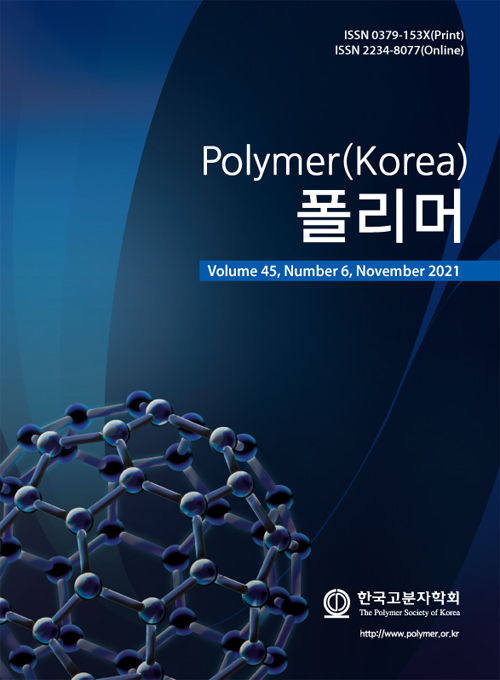- Control of Dissolution Rate of Sodium-Alginate/Polyacrylamide Hydrogel for Selectively Dissolvable Water-Blocking Device
Gwang-Mook Choi†
 , Jin-Ju Choi, Woo-Cheol Kim*, Hwanmin Hwang**, Myungwoong Kim**, and Min-Jun Kim†
, Jin-Ju Choi, Woo-Cheol Kim*, Hwanmin Hwang**, Myungwoong Kim**, and Min-Jun Kim† 
Advanced Materials & Processing Center, Institute for Advanced Engineering, Yongin 17180, Korea
*R & D Institute, Korea District Heating Corp., Yongin 17099, Korea
**Department of Chemistry and Chemical Engineering, Inha University, Incheon 22212, Korea- 선택적 수용성 차수재 개발을 위한 나트륨-알지네이트/폴리아크릴아마이드 하이드로겔의 수용 속도 제어
고등기술연구원 신소재공정센터, *한국지역난방공사 미래개발원, **인하대학교 화학·화학공학 융합학과
Reproduction, stored in a retrieval system, or transmitted in any form of any part of this publication is permitted only by written permission from the Polymer Society of Korea.
The objective of this study was to examine changes in the dissolution rate of sodium-alginate/polyacrylamide (SA/PAM) hydrogel according to water temperature and concentration of cross-linking agent N,N'-methylenebisacrylamide (MBAAm). Results confirmed that swelling and dissolution rates of the SA/PAM hydrogel were increased when the temperature of the water was increased or the amount of MBAAm was decreased. When water temperature was increased, ionic crosslinks became unstable and amide bonds were broken due to hydrolysis, causing the hydrogel to rapidly dissolve in the hot water. Also, after the amount of MBAAm was decreased, ionic crosslinks became dominant and SA/PAM hydrogel became more vulnerable to hot water. Here, we analyzed the dissolution rate of hydrogel following temperature and MBAAm density changes. We also developed a selectively dissolvable water-blocking hydrogel that could be stable in cold water and become dissolved quickly in hot water.
본 연구에서는 나트륨-알지네이트/폴리아크릴아마이드(SA/PAM) 하이드로겔의 온도 및 가교제로 작용하는 N,N′-메틸렌비스아크릴아마이드(MBAAm) 농도에 따른 수용 형태 및 시간 변화를 분석하였다. 실험 결과, 수온이 증가하거나 가교제 농도가 감소할수록 SA/PAM 하이드로겔의 팽윤 및 수용 속도가 증가함을 확인하였다. 수온 상승 시 이온결합이 불안정하고 아마이드 결합이 깨지면서 하이드로겔의 수용 속도를 증가시키는 반면, MBAAm의 밀도 감소 시에는 주요 결합력인 이온결합력이 약화되어 고온수에 취약함을 확인하였다. 본 연구를 통해 SA/PAM 하이드로겔의 수용속도의 제어가 가능함을 증명하였고 선택적 수용이 가능한 차수재로서의 가능성을 제시하였다.
Keywords: sodium-alginate/polyacrylamide hydrogel, dissolution rate, temperature effect, cross-linking density effect, selectively dissolvable water-blocking material.
- Polymer(Korea) 폴리머
- Frequency : Bimonthly(odd)
ISSN 0379-153X(Print)
ISSN 2234-8077(Online)
Abbr. Polym. Korea - 2023 Impact Factor : 0.4
- Indexed in SCIE
 This Article
This Article
-
2021; 45(6): 841-848
Published online Nov 25, 2021
- 10.7317/pk.2021.45.6.841
- Received on Mar 17, 2021
- Revised on May 20, 2021
- Accepted on Jun 2, 2021
 Correspondence to
Correspondence to
- Gwang-Mook Choi, and Min-Jun Kim
-
Advanced Materials & Processing Center, Institute for Advanced Engineering, Yongin 17180, Korea
- E-mail: gmchoi@iae.re.kr, minjun@iae.re.kr








 Copyright(c) The Polymer Society of Korea. All right reserved.
Copyright(c) The Polymer Society of Korea. All right reserved.